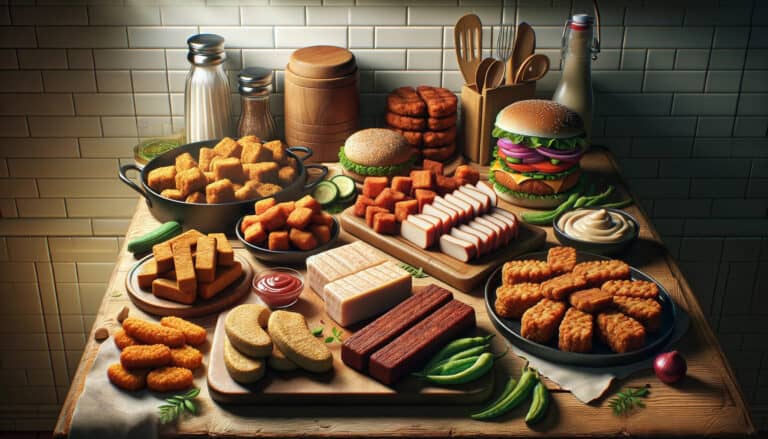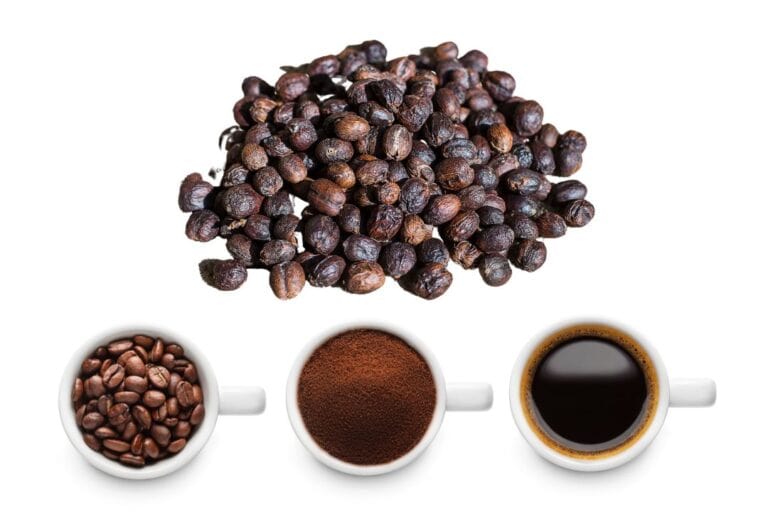Are Brown Spots Inside Bell Pepper Safe to Eat
Brown spots inside bell peppers can be a cause for concern, especially when you’re looking forward to enjoying fresh peppers from the grocery store.
These spots may differ in appearance, with some showcasing a brown color while others might exhibit small black spots or even concentric rings. These spots often raise questions about the safety of consuming the rest of the pepper.

A fungal or bacterial infection is one of the most common reasons for brown spots on bell peppers. Bacterial leaf spots, for instance, can cause dark spots on the skin of peppers.
Another culprit could be a fungal pathogen, which thrives in humid conditions and can infect the entire plant. Infected plant debris left in the soil can also contribute to the spread of fungal disease the following season.
Inconsistent watering and a lack of calcium are other factors that might lead to brown areas developing on your bell peppers. [verified12.] These conditions and high temperatures can also affect different peppers, such as green, hot, and sweet bell peppers, causing similar issues.
Inspecting the pepper seeds and the stem end is crucial when encountering brown peppers. Moldy seeds or a moldy part of pepper are clear signs of spoilage; consuming such peppers is not advisable.

The brown parts should be cut away, ensuring the cut bell peppers remain safe to eat. It is generally safe if the vibrant color is maintained in the rest of the fruit.
Storing peppers properly is one of the best preventative measures to avoid these issues. Keeping your fresh bell peppers in an airtight container with a paper towel at the bottom or in the crisper drawer of your refrigerator can help maintain their freshness for a couple of days.
Placing cut peppers in freezer bags is the best way to preserve their vitamin C content and vibrant color if you plan to store them longer.
Removing infected plant debris and ensuring 2-4 inches of water per week for those growing bell pepper plants can prevent fungal diseases.
Additionally, rotating soil types and planting in peat pots can ensure vigorous foliage and protect the plants from bacterial spots and other common pepper plant problems.
It’s also worth noting that brown spots can be a natural process in mature fruit, especially in sweet and yellow bell peppers. Observing the pepper’s color and ensuring no signs of bacterial or fungal infection are the easiest ways to determine if the pepper is safe to eat.
Signs of a Spoiled or Bad Bell Pepper

Identifying spoilage in bell peppers
It’s essential to know how to spot symptoms of spoilage, such as black spots. One common cause of black spots is blossom end rot. Brown spots inside a green pepper can indicate blossom end rot.
It may also have black seeds instead of red, which can signify that it has gone bad. However, there are other visual cues and symptoms you should look out for, such as black spots inside and red coloration.
Visual cues indicating a bad bell pepper
- Mold: If you notice any fuzzy patches, black spots, or greenish-blue mold on the surface of the bell pepper, along with brown seeds, red color, and symptoms, it is best to discard it.
- Wrinkled skin: A wrinkled or shriveled appearance, brown seeds, black spots, and green bell peppers is often a sign of symptoms that the pepper has lost its freshness and is no longer suitable for consumption.
- Soft spots: Press gently on the surface of the pepper; if you feel any soft or mushy areas, it’s a clear indicator that the pepper has started to spoil. Additionally, check for brown seeds or red discoloration inside the pepper, as these are symptoms of spoilage.
Understanding when to discard a spoiled bell pepper
- Bitter taste: If your bell pepper tastes bitter instead of its usual sweet flavor, it may have gone bad due to over-ripening or improper storage. Look for symptoms such as brown seeds red or black spots.
- Discoloration: Any significant color changes beyond normal ripening, such as darkening or browning, can indicate spoilage. This may include the presence of black spots on the red pepper plants and changes in the color of the seeds.
- Texture changes: If the texture of the flesh feels slimy or rubbery with brown seeds and red or black spots instead of firm and crisp, this suggests that the bell pepper is past its prime.
Noticing changes in texture and smell as indicators of spoilage
- Blossom end rot: This condition causes blackened areas at the bottom end of pepper plants’ fruit, making it unsuitable for consumption. A deficiency in seeds often causes it.
- Foul odor: If your bell pepper emits an unpleasant smell like fermentation or rotting, has black spots, or contains rotten seeds, it’s best not to consume it.
Differentiating between black spots and brown seeds in bell peppers
When examining bell peppers, it’s important to distinguish between black spots and brown seeds. Black spots are areas on the pepper’s skin that appear darker than the rest of the surface due to the presence of seeds.
On the other hand, brown seeds with black spots refer to the coloration of the seeds found inside the pepper.
Examining the causes behind black spots and brown seeds
Various factors, including bruising, insect damage, disease, or seed issues, can cause black spots on bell peppers. These spots may also develop due to natural aging or exposure to extreme temperatures in pepper plants.
The seeds of the pepper plants are especially susceptible to these spots. Brown seeds, however, are a normal part of a bell pepper’s development process and do not indicate spoilage. Additionally, it is essential to note that the presence of black spots on the peppers does not necessarily mean they are rotten or inedible.
Determining if black spots affect the edibility of bell peppers
While black spots on bell peppers may not look appealing, they typically do not render the entire pepper inedible. Seeds usually cause these spots and can be safely removed before consumption.
In most cases, you can cut away any black spots or damaged areas before using or consuming the remaining portion with seeds. However, discarding the pepper if extensive mold growth or an unpleasant odor accompanies the black spot on the sources is best.
Discussing whether brown seeds indicate spoilage or are harmless
Contrary to popular belief, black spots on brown seeds in bell peppers are harmless and do not signify spoilage. As mentioned earlier, these black spots occur naturally during seed maturation and do not affect the taste or quality of the seeds.
Therefore, you can confidently consume bell peppers with brown seeds and black spots without any safety concerns.
Recognizing and Addressing Moldy Bell Peppers
Identifying signs of mold on bell peppers
It’s crucial to recognize the signs of mold. Mold on bell peppers can manifest in various ways, including fuzzy or powdery growth, discoloration, and a rotten smell. If you notice any of these indicators on your sweet bell pepper, it’s best to exercise caution.
The potential health risks associated with consuming moldy produce
Consuming moldy food, including moldy bell peppers, can pose potential health risks. Mold exposure can lead to allergic reactions or respiratory issues in some individuals.
Certain molds produce mycotoxins that can cause illness if ingested. Therefore, it is advisable to avoid eating the moldy part of a bell pepper.
Proper disposal methods for moldy bell peppers
When faced with a moldy bell pepper, proper disposal is essential. To prevent the spread of spores and potential contamination, seal the affected pepper in a plastic bag before disposing it in the trash.
This helps contain any fungal diseases, such as powdery mildew or root rot, that may have caused the mold growth.
Tips for preventing mold growth on stored or refrigerated bell peppers
To minimize the risk of encountering mold on your stored or refrigerated bell peppers:
- Ensure low moisture content: Excess moisture can promote fungal growth, so make sure your peppers are dry before storing them.
- Store in a cool place: Avoid warm and humid environments as they facilitate mold development.
- Separate damaged peppers: Remove any bruised or damaged peppers from the rest to prevent further spread of fungi.
- Use breathable containers: Opt for storage containers that allow air circulation to reduce condensation and inhibit mold growth.
- Regularly inspect and discard spoiled peppers: Check your stored bell peppers frequently for signs of decay or mold, and promptly discard any affected ones.
By following these tips, you can help maintain the freshness and safety of your bell peppers while minimizing the risk of encountering mold. Remember, it’s always better to err on caution and dispose of any questionable produce when in doubt.
Preventing and dealing with blackening inside bell peppers
Understanding why internal blackening occurs in some Bell Peppers
Internal blackening in bell peppers, also known as brown or black spots, can be caused by various factors. One common cause is “internal chilling injury,” which happens when the peppers are exposed to temperatures below 50°F (10°C) for an extended period.
Other causes include physical damage during harvesting or handling and fungal or bacterial infections.
How to prevent internal blackening during storage
Handling bell peppers properly is essential to prevent internal blackening during storage. Here are some tips:
- Store bell peppers above 50°F (10°C) to avoid chilling injury.
- Keep bell peppers away from ethylene-producing fruits like apples and bananas, as ethylene can accelerate ripening and increase the likelihood of internal blackening.
- Store bell peppers in a cool, dry place with good air circulation.
- Avoid storing bell peppers near foods with strong odors that the peppers can absorb.
Strategies for salvaging partially affected Bell Peppers
If you notice mild internal blackening in your bell pepper, but it hasn’t spread extensively, there are ways to recover them:
- Cut out the affected portion: Slice open the pepper and remove any discolored areas before using it in recipes.
- Cook thoroughly: Cooking the pepper can help mask any remaining discoloration.
When is it best to discard Bell Peppers with internal blackening?
Unfortunately, there may be instances where salvaging the bell pepper is not possible due to extensive internal blackening or mold growth. In such cases, it’s best to err on caution and discard the affected pepper.
Remember, while internal blackening may not necessarily make a bell pepper unsafe to eat, it can affect its taste and texture. By understanding the causes and taking preventive measures, you can minimize the occurrence of internal blackening and enjoy fresh, vibrant bell peppers in your meals.
The ripening process of bell peppers: from green to yellow or orange
Stages involved in the ripening process
Bell peppers go through a fascinating transformation as they ripen, changing from green to vibrant shades of yellow or orange. This ripening process occurs in several stages, each marked by color changes.
Initially, bell peppers start as small, firm fruits with a light green hue. As they continue to mature, they gradually transition into their final colors.
Factors influencing color change
Various factors influence the color change in bell peppers. One crucial factor is the pepper variety itself. Different pepper varieties have varying maturation periods and exhibit different colors when ripe.
Environmental conditions such as sunlight exposure and temperature can impact the rate at which the peppers change color.
Optimal time for harvesting different colored Bell Peppers
Knowing the optimal time to harvest bell peppers of different colors is vital to enjoying their best flavor and texture. Green bell peppers are typically harvested before they fully mature when they are still crisp and have a slightly bitter taste.
On the other hand, yellow or orange bell peppers are left on the plant longer to reach their full maturity and develop their sweet flavor profile.
Flavor differences between green, yellow, and orange Bell Peppers
The flavor of bell peppers can vary depending on their stage of ripeness. Green bell peppers have a more robust and slightly bitter taste than their sweeter counterparts – yellow and orange bell peppers.
As the fruit matures, its sugar content increases, resulting in a milder and sweeter flavor profile.
Ensuring the safety of eating bell peppers with brown spots
In conclusion, while brown spots inside bell peppers may not always indicate spoilage, it is essential to exercise caution when consuming them. Brown spots can show internal bruising or natural aging, indicating mold or decay.
Inspect the pepper thoroughly for any signs of mold or rot before deciding whether to consume it. If the brown spots are limited and do not appear to affect the overall quality of the pepper, they can usually be cut out without compromising its safety.
To ensure your safety when consuming bell peppers with brown spots, it is best to follow these guidelines:
- Scrutinize the pepper for any signs of mold or rot.
- Cut out any brown spots that appear suspicious or affect a large portion of the pepper.
- Wash the remaining parts of the pepper thoroughly before use.
- If in doubt, discard the pepper to avoid potential health risks.
By following these precautions, you can enjoy bell peppers safely and minimize any potential risks associated with consuming those with brown spots.
FAQs – Are Brown Spots Inside Bell Pepper Safe to Eat?
Can I eat bell peppers with black seeds?
👉 Yes, black seeds in bell peppers are safe to eat. The color change from white (immature) to black (mature) is a natural part of the ripening process and does not indicate spoilage or health concerns.
How do I prevent blackening inside my bell peppers?
👉 To prevent blackening inside bell peppers, store them properly in a cool, dry place away from direct sunlight. Avoid exposing them to extreme temperatures, which can accelerate decay and discoloration.
Are green bell peppers safe if they have some yellow patches?
👉 Yes, green bell peppers with yellow patches are safe to eat. These patches are part of their ripening process and do not affect their safety or taste.
Can I still use bell peppers with moldy spots?
👉 It is best to discard bell peppers with moldy spots. Mold can spread quickly and produce harmful toxins, so it is not advisable to consume peppers showing mold signs.
How long do bell peppers last before they spoil?
👉 When appropriately stored in the refrigerator, bell peppers typically last about 1-2 weeks. However, their freshness and quality may decline after the first week.
Using them as soon as possible is recommended for optimal taste and texture.

Born and raised in a family of foodies, Georgia’s passion for cuisine was nurtured from a young age as she learned the intricacies of flavor and texture from her grandmother’s kitchen. As an adult, this early fascination blossomed into a full-fledged love affair with the culinary world.








